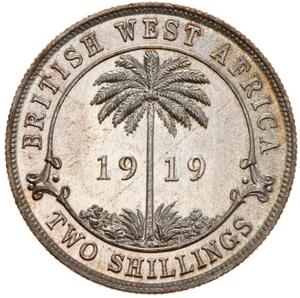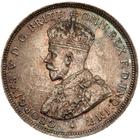The Two Shillings coin was the largest circulating denomination of the British West African Pound. As with its British counterpart (called a Florin), two shillings were equal to 24 pence, or to one tenth of a one pound.
In the 19th century, the (pre-decimal) pound sterling became the currency of the British West African territories and standard issue United Kingdom coinage circulated for a while. The West African territories in question were Nigeria, the Gold Coast (now Ghana), Sierra Leone and The Gambia.
In 1912, the authorities in London set up the West African Currency Board and issued a distinctive set of sterling coinage for use in British West Africa. The circumstance prompting this move was a tendency for existing UK coins used in the West African territories to leave the region and return to the UK, hence causing a local dearth of coinage. A unique British West African variety of the sterling coinage would not be accepted in the shops of Britain and so would remain in circulation locally.
Consequently, the British West African two shillings were made very different from their Imperial counterparts. Apart from changing to base metals earlier than the Imperial coinage, two visible differences were the local reverse and the fact that the monarch's effigy on the obverse was crowned - to signify the status of the coinage as being colonial. The monarch's legend though was the same as on standard British coinage (in Latin).
There were three types issued:
- silver coins - 1913 - 1920 (first sterling, then debased in 1920), for King George V
- tin brass coins - 1920 - 1936, for King George V
- nickel brass coins - 1938 - 1952, for King George VI
No 2 shilling coins were issued for King Edward VIII or Queen Elizabeth II in British West Africa.
The British West African pound was also adopted by Liberia in 1907, replacing the Liberian dollar, although it was not served by the West African Currency Board. Liberia changed to the U.S. dollar in 1943. Togo and Cameroon adopted the West African currency in 1914 and 1916 respectively when British and French troops took over those colonies from Germany as part of World War I.
After decolonisation, the coins were replaced by the various new countries as they introduced their own independent currencies:
- Nigeria introduced the Nigerian Pound in 1958
- Ghana introduced in Ghanaian Pound in 1958
- British Cameroon (on unification with Cameroon) adopted the Central African CFA Franc in 1961
- Sierra Leone introduced the Leone in 1964
- Gambia introduced the Gambian Pound in 1965
In some places, British West African coins circulated in parallel with the new coinage until 1968. | 





